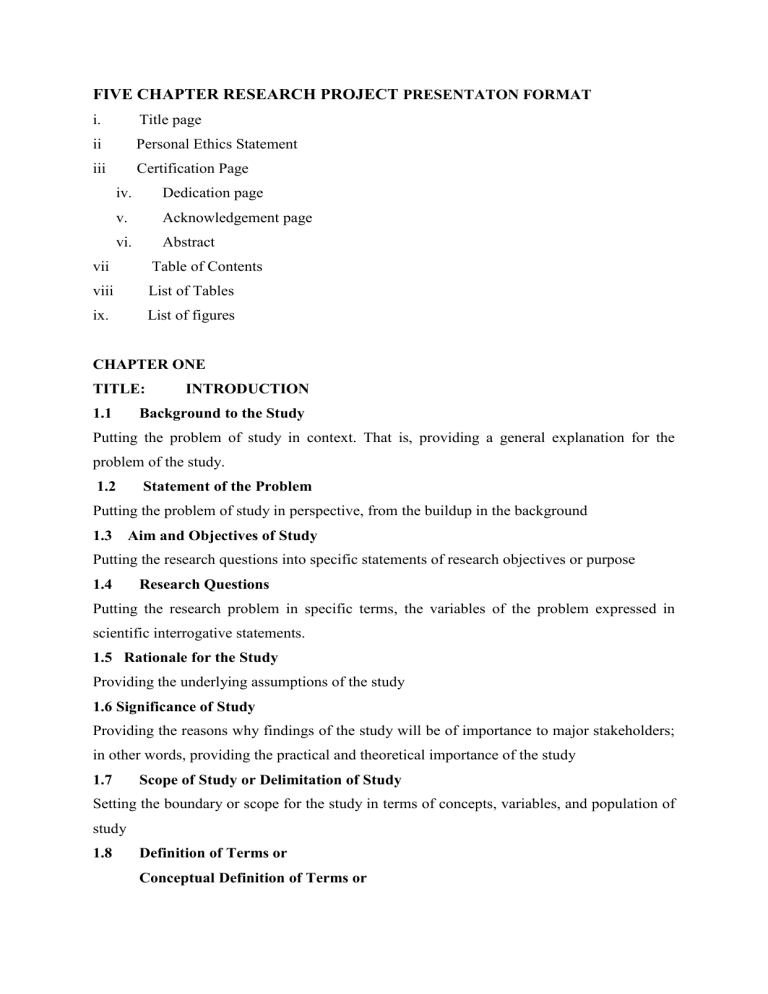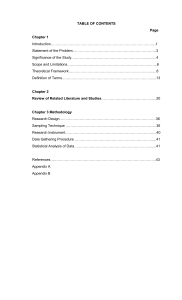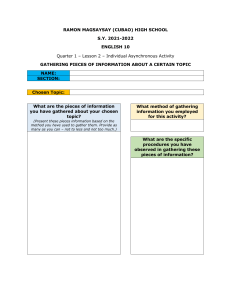
FIVE CHAPTER RESEARCH PROJECT PRESENTATON FORMAT i. Title page ii Personal Ethics Statement iii Certification Page iv. Dedication page v. Acknowledgement page vi. Abstract vii Table of Contents viii List of Tables ix. List of figures CHAPTER ONE TITLE: 1.1 INTRODUCTION Background to the Study Putting the problem of study in context. That is, providing a general explanation for the problem of the study. 1.2 Statement of the Problem Putting the problem of study in perspective, from the buildup in the background 1.3 Aim and Objectives of Study Putting the research questions into specific statements of research objectives or purpose 1.4 Research Questions Putting the research problem in specific terms, the variables of the problem expressed in scientific interrogative statements. 1.5 Rationale for the Study Providing the underlying assumptions of the study 1.6 Significance of Study Providing the reasons why findings of the study will be of importance to major stakeholders; in other words, providing the practical and theoretical importance of the study 1.7 Scope of Study or Delimitation of Study Setting the boundary or scope for the study in terms of concepts, variables, and population of study 1.8 Definition of Terms or Conceptual Definition of Terms or Operational Definition of terms Defining the relevant terms or variables in their literal sense (i.e. conceptually) or in the sense in which each variable or concept will be examined or measured in the study (operationally). References Providing chapter-specific references or citations in alphabetical order using the APA referencing format which is the standard referencing format accepted for research projects by the School of Communication of the Lagos State University CHAPTER TWO TITLE: LITERATURE REVIEW Provide an organizational statement introducing the arrangement of the chapter’s content. This should be done without necessarily putting a subtitle “introduction” 2.1 Conceptual Review Provide a review of the meaning and comments, critiques etc. by scholars, authors, professionals etc on each of the relevant concepts or variables of the study 2.2 Empirical Review Provide a review of similar but relevant studies from the points of view of purpose, method, major findings and relevance to the present study 2.3 Theoretical Framework Provide a review, and critique of relevant theory or theories that will be needed to frame the study; that is, help to explain and discuss findings of the study from the theoretical perspective 2.4 Conclusion Provide an explanation of what you can make out of the overall review with a view to identifying a missing gap in knowledge which findings of the present study will help to fill or bridge References Provide chapter- specific references or citations in APA format. CHAPTER THREE TITLE: METHOD OF STUDY Provide an introductory paragraph for the chapter as explained for chapter two 3.1 Research Design Provide an explanation of the method of data gathering that would be employed for the study as well as justification for choosing same. 3.2 Population of Study Provide an explanation of the study population and the study location as well as justification for your choices. What is the sampling frame? (that list or document containing your population of study)? Is it the national population census figure or the school register of a secondary school or website containing the list of voters in a constituency? 3.3 Sampling Technique and Procedure or Sample Size and Sampling Procedure Provide an explanation of the number of people to be sampled or examined from the study population (i.e. the sample size) which constitute the representative sample, the sampling method(s) or technique(s) to be used in selecting the sample size as well as the procedure or step by step process of the selection (that is, how the sampling technique(s) will be used to select the sample size) NOTE: Not every study makes use of human beings as the study population. Some studies make use of inanimate objects as study population, or a combination of inanimate objects and human beings. Example is a content analysis study which makes use of newspaper articles, news reports, editorials etc. as study population. However, the explanation above is the template for the explanation of the sampling procedure for whatever type of study. 3.2 Research Instrument(s) or Data Gathering Instrument(s) Provide an explanation of the instrument(s) you would administer to your representative sample in order to collect or gather relevant data for the study. Description should cover format, content and relevance of the data gathering questions in the instrument(s) to the study’s research questions. 3.3 Validity and Reliability of Study Provide an explanation of what you have done to ensure that research instrument(s)-would measure or examine what it (or they) is (are) expected to measure or examine (validity), and would consistently provide similar results when applied to similar samples (Reliability) 3.6 Method of Data Collection or Procedure for Data Collection Provide an explanation of how you would collect the data from the representative sample 3.7 Method of Data Analysis Provide an explanation of how you would analyse the data to be gathered from the points of view of treatment relating to quantitative or qualitative analysis or both. NOTE: This chapter is written in the futuristic sense (as a proposal). You are expected to convert your explanations to the past tense once you have completed the study. This goes for all subsections in the chapter CHAPTER FOUR TITLE: DATA ANALYSIS AND DISCUSSION OF FINDINGS Content of the chapter should also be explained through an organizational statement representing the chapter’s introduction 4.1 Demographics of Respondents Provide an explanation of the demographics or characteristics of the respondents, without necessarily plotting tables relating to each demographic variable of sex, age, education, income, religion etc. 4.2 Answer to Research Questions Arrange data presentation according to research questions, starting with research question one. All data and tables relating to research question one should be presented in logical order or related sequence till all findings relating to each research question have been analyzed and interpreted. For a qualitative study, the same arrangement of data presentation applies but without data tables. 4.3 Summary of Major Findings Provide a list of the major findings of the study in the order in which the research questions have been addressed or answered through the data presentation in the previous section. This is a short description of each finding of the study. 4.4 Discussion of Findings Provide a detailed explanation of the major implications of each of the findings of the study as listed in the previous section of the chapter. The implications or inferences are drawn and discussed by linking each of the major findings with the reviewed literature or body of knowledge related to the research problem as documented in chapter two dealing with review of relevant or pertinent literature. The study’s findings are discussed to bring out their implications by linking them up with reviewed concepts, empirical studies and theoretical statements or postulations and/or their predictions. References Provide chapter-specific reference or citations as used in the chapter, particularly under discussion of findings. CHAPTER FIVE TITLE: SUMMARY, CONCLUSION AND RECOMMENDATIONS The chapter should also be introduced as with other chapters 5.0 Summary of the Study Provide a summary of the study covering purpose of the study, which should capture the problem of study, as well as theories used in framing the study, method(s) adopted in gathering relevant data for the study and major findings of the study 5.1Conclusion Provide an explanation of the study’s conclusion, that is, what you can make out of the implications of the study’s findings as they relate to the problem area addressed by the study. 5.2 Recommendations Provide a list of recommendations to (or what should be done by) major stakeholders related to the study area. The recommendations are the offshoots of your conclusion. 5.3 Limitations of Study Provide an explanation of the inherent weaknesses of the study related to methods adopted in gathering data for the study, instruments used in gathering the data, and the sampling procedure. Primary limitations of the study are derived from issues relating to methods of data gathering. Constraints, challenges and unpleasant field experiences constitute secondary limitations and could be reported. 5.4 Suggestions for Further Study Provide an explanation of possible aspects or perspectives to your research problem that future researchers can work on. Your delimitation of the study or setting the scope for your study as captured in chapter one under the appropriate section of the chapter “delimitations of study” or “scope of study” should inform what you suggest to future researchers to work on. Those perspectives of the research problem not covered by your study as pointed out under delimitations of the study should be the basis for your suggestions. BIBLIOGRAPHY Provide an alphabetical arrangement of all sources cited throughout the different chapters of the study. Alternatively you can present this section as “REFERENCES” in which case all the citations are presented in alphabetical order without necessarily breaking them into different components or sections. APPENDIX Present relevant materials that can help the reader better appreciate your effort in conducting the study or under certain sections of the study better. The first material to be presented as Appendix 1 should be your research instrument followed by other materials. If you have more than one research instrument, one of them should as Appendix 1, the other or others as Appendix 2, 3 respectively before presenting other materials as appendix 4 etc. ABSTRACT Abstract comes as the last at the preliminary pages before the presentation of your chapter one. Abstract is like an executive summary of a major business or professional report. The study’s abstract should capture the purpose of the study reflecting the problem of the study examined, related theory(ies) used as theoretical framework for the study, method(s) adopted in gathering data for the study, major findings of the study, implication(s) of some of the significant findings, and the study’s recommendation(s) derived from those implications. NOTE: This five-chapter framework is also adaptable to production-based studies. This depends on the foresight and the creativity of the project supervisor, reflective in how he or she guides the student supervisee. Adapted by the Publications Committee of School of Communication, LASU. September, 2021.Jide Jimoh




